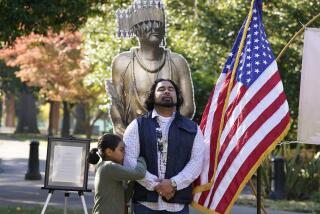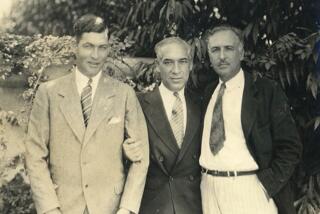Last of the Kwaaymii : Nightlong Ritual Honors Tribeâs Final Full-Blooded Indian
Unlock his soul--It is captured in the raindrop.
Bursting out of this life shell, the courier of warriors
takes his place among the comets and stars.
Rest his soul--the raindrop having performed its work,
Is free at last.
--Traditional Indian chant
In the cold, clear dawn off Sunrise Highway in the Laguna Mountains, the spirit of Tom Lucas, the last full-blooded Kwaaymii Indian, was released from earth in a ceremony passed down from generations past.
The Indian rite--traditionally conducted a year after death--contained both Catholic ritual and Indian custom and drew more than 100 friends and family members to the remote Lucas Ranch, once a Kwaaymii Indian reservation.
The ceremony began at sunset Friday and climaxed at dawn Saturday with the burning of Lucasâ possessions, an act which signalled his spiritâs release from earth.
Indian belief is that if the spirit is released at dawn, and earthly possessions burned, the spirit will rise with the rising sun and will take with it the treasured possessions of this world on its journey.
A group of six Indian bird singers, who tell fables through their chanting, led the all-night wake held in a clearing near a cabin which Lucas had built for his family 50 years ago. Weird shadows cast by the figures around a bonfire ebbed and flowed during the wake as Indians and Anglos followed the lead of the singers in slow, rhythmic, shuffling dances to the beat of gourd rattles and the sing-song Indian chants.
Each segment of the ceremony must be performed in exactly the same way and at the precise moment as it has been for generations, explained Ron Christman, leader of the Indian bird singers. âThe creator gave this to our people and who would change it?â he said. âIt is not our way.â
Christman learned the spirit ceremony ritual from a Kumeyaay tribal elder and has passed on his bird singing to his four sons, two of whom participated with their father in the Lucas wake this past weekend. The Kwaaymii were a subtribe of the Kumeyaay tribe. Christmanâs father was a wildcat singer; his uncle, a lightning singer. Each are different styles of chanting.
The songs in the ceremony tell the tales of animals and carry lessons for humans, Christman explained. Participants gathered from as far away as Arkansas and Northern California for the event commemorating Lucasâ life and the release of his spirit.
Some stayed in tepees at sites on the ranch where poles had been erected for that purpose. Others stayed in campers parked under the pines. Still others stayed in nearby Julian or drove from their homes to the Lucas Ranch--once part of the vast Kwaaymii lands that extended throughout the Lagunas.
While the men sang and danced outside, the women remained inside the Lucas cabin, praying and singing in both Indian and Anglo fashion. An altar was erected for the womenâs rites. On it was a picture of Lucas taken only a few months before his death, and candles, which were extinguished shortly before a final procession to Lucasâ grave at mid-day Saturday.
Catholic priests attempted to halt such Indian ceremonies when they converted tribal members to their faith, Christman said, but failing that, âthey added their ritual to our ceremonies.â
âIt does not matter so much because there is only one creator,â Christman explained. âWe all pray to Him.â
All gathered for the ceremony at sunrise, consigning Lucasâ earthly belongings to the flames of a bonfire, adding a little sourgrass to ease his spiritâs journey.
The last of Lucasâ belongings to be burned was a hard hat that Lucas had worn during his many years with the R.E. Hazard Construction Co. âWhen I saw that hat, it really got to me,â said Lucasâ daughter, Jacquelyn Pfingst.
Lucas, who died at age 86 on Dec. 21, 1989, was born during a 1903 blizzard in a cabin only a few feet from where the ceremony was held, and those who came to commemorate him reflected his life--spent in both the traditional Indian culture and in the white manâs world.
As a child, Lucas had no other Indian youths to play with. He was the last child born in the Kwaaymii tribe. The Kwaaymii elders, realizing that he alone would be left to carry on the tribeâs traditions and culture, drilled him nightly in tribal lore.
In his later years, Lucas recounted those early lessons, over and over, to historians and all who were interested in hearing them, never varying or forgetting.
But, for most of his life, Lucas lived in the white manâs world, attending public school not Indian school, learning English and joining the Catholic Church, taking an Anglo wife and later moving to Pacific Beach to raise his family there.
He worked in the white manâs world, as a cowhand, a miner, a movie extra, a federal Conservation Corps foreman, a plumber, a civilian explosives expert during World War II, and as a heavy construction worker, building roads and freeways. He returned to his home in the Lagunas to farm during the Great Depression and again after his wife, Gerria, died in 1970, and after his retirement from Hazard Construction at the age of 70.
But Lucas, for many years, was not at peace with either of his worlds. He rarely returned to his Indian culture except for ceremonies such as the one held for him this weekend. Yet he defied the white menâs laws that took away the lands of his Kwaaymii ancestors.
Lucas said in an interview before his death that by using âall the money I had and a very smart lawyer,â he convinced the courts and Congress to deed to him the former Indian land on which he had been born and where he and his ancestors are buried. In 1947, then-President Harry Truman signed the papers deeding the 320-acre reservation to him, as the last full-blooded Kwaaymii. The ranch now belongs to his daughters, Carmen Lucas, who returned to the Kwaaymii land with her father about eight years ago, and Jacquelyn Pfingst.
On Saturday, a Catholic priest, the Rev. Alan Beauregard of Barona Indian Mission, and members of Lucasâ family led a procession of more than 100 people to Lucasâ grave site near where his mother, grandmother and many of his ancestors are buried. The graveside services included eulogies by Lucasâ friends of many religions and races. All praised Lucas for trying to unify the two worlds in which he walked.
The final ceremonies were Indian. Family members spread bolts of colorful cloth across the grave, which were then picked up by nonfamily members in a ceremony symbolic of earlier times when tribal members with little means traveled long distances to attend the spirit ceremony and were given gifts of food and clothing for their journey home.
Then the bird singers led the group of many races and backgrounds in ceremonial dances at the grave of Lucas.
The Indian spirit ceremonies are held to help those closest to him end their mourning and also to show the creator âthat this was a man who had come back to the traditional ways,â Christman explained.
âHe antagonized a lot of Kumeyaay,â Christman said of Lucas. âSome say he deserted us and went into the white manâs world. He walked in so many paths. This is to call attention to him, to show his grandfathers that he was well respected, so that they will find a suitable place for him on his journey.â
More to Read
Sign up for The Wild
Weâll help you find the best places to hike, bike and run, as well as the perfect silent spots for meditation and yoga.
You may occasionally receive promotional content from the Los Angeles Times.






